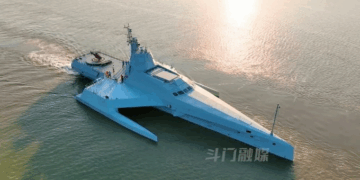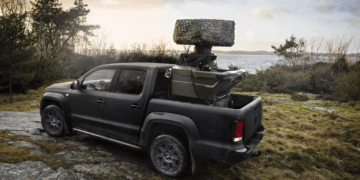Following Ukraine’s effective use of sea drones against Russian naval vessels, Taiwan is reportedly venturing into the development of uncrewed surface vessels (USVs) to boost its naval strength. Production of two prototypes is set to begin in 2026.
Observing Ukraine’s success with sea drones during the 2022 conflict, Taiwan aims to replicate this strategy by focusing on attack-oriented sea drones. These drones will be adept at launching surprise attacks and neutralizing threats while ensuring minimal human casualties. On Nov. 2, government sources confirmed that Taiwan intends to harness drones across different terrains, including air, land, and both above and underwater. Such drones can undertake various roles ranging from reconnaissance to offensive actions, mine clearing, and torpedo removal, as mentioned by the Liberty Times.
The National Chung-Shan Institute of Science and Technology (NCSIST) has pioneered an uncrewed boat equipped with live video broadcasting capabilities and an array of features, including radio frequency simulators, jamming systems, flamethrowers, and radar signal reflectors. This boat is fit for live-fire training drills, offering a realistic simulation to assess weapon efficacy, according to the NCSIST website. NCSIST further highlighted that this platform can be merged with other USV projects to augment radar, weaponry, sonar, and other modules, catering to roles like coastal defense, offensive actions, mine detection, and anti-submarine operations.
For the creation of two distinct attack sea drones, a budget of NT$812 million (US$25 million) has been set aside. These USVs will be controlled remotely within a 70-kilometer radius, and their designs will emphasize stealth features to enhance their ability to launch unexpected attacks, as sourced from military insiders by the Liberty Times.
Strategic Importance of Unmanned Surface Vehicles (USVs) in the American Naval Doctrine:
- Force Multiplier: USVs act as force multipliers. A single naval vessel can deploy multiple USVs, which can significantly expand the reach and capabilities of that vessel without the need to increase personnel or put them at risk.
- Cost-effective: Building and maintaining USVs is generally cheaper than manned ships. This affordability allows for the deployment of numerous USVs without straining the naval budget, creating a numeric advantage.
- Advanced Surveillance: With advancements in sensor technology, USVs can act as advanced reconnaissance platforms, scanning large areas of the ocean and relaying information in real-time. This aids in the detection of potential threats and allows for early action.
- Reduced Risk: Operating without a crew eliminates the risk of casualties. In contested regions or during high-intensity operations, USVs can be sent into potentially dangerous areas without the fear of human loss.
- Highly Adaptable: USVs can be outfitted with various modules, including offensive weapons, electronic warfare equipment, or mine detection systems. This adaptability allows them to fulfill multiple roles, from anti-submarine warfare to mine clearance.
- Stealth and Persistence: USVs, especially when designed with stealth in mind, can operate covertly, making them harder to detect. Their ability to stay operational for extended periods without the need for crew rest enhances their persistence in surveillance and reconnaissance roles.

How the Doctrine Could Benefit Taiwan’s Fleet Against China’s Military Build-up in the South China Sea:
- Numerical Advantage: China’s naval build-up in the South China Sea is significant. Adopting a USV-centric doctrine would allow Taiwan to rapidly increase its naval presence and capabilities without incurring prohibitive costs.
- Deterrence: A fleet of USVs, armed and capable, can act as a deterrent against aggressive actions, as they present a clear risk to any hostile vessel.
- Surveillance and Intelligence: Given the vast expanse of the South China Sea and the numerous islands, reefs, and shoals, USVs can provide continuous surveillance, ensuring that Taiwan is always aware of any Chinese naval movements or activities in the region.
- Minimize Vulnerability: USVs reduce the risks associated with human crews, ensuring that Taiwan can defend its interests without incurring unacceptable human losses.
- Rapid Response: USVs can be quickly deployed to hotspots or areas of interest. Their extended operational endurance means they can remain on station for longer periods, ensuring continuous presence and capability.
- Integration with Allies: Adopting a strategy that aligns with American naval doctrine may foster deeper military cooperation between Taiwan and the U.S. or other regional allies. Such integration could provide Taiwan with more extensive intelligence sharing, joint training exercises, and technological collaboration.
In conclusion, by embracing a USV-centric naval strategy, Taiwan could significantly enhance its maritime capabilities, ensuring it is better prepared to address the challenges posed by China’s military build-up in the South China Sea. This approach would not only offer a cost-effective way to bolster Taiwan’s naval strength but also provide a flexible and adaptable platform to address various maritime threats.

Cooperation Between USV and a Combat Navy Destroyer in Network-Centric Operations:
Network-centric operations emphasize the use of a comprehensive information and communications network to enhance the speed, accuracy, and effectiveness of military operations. For naval warfare, the combination of a Combat Navy Destroyer and Unmanned Surface Vehicles (USVs) operating in a network-centric environment can provide a formidable capability to neutralize enemy naval assets and fortify maritime dominance.
- Advanced Reconnaissance:
- USVs can be deployed ahead of the destroyer to scout and gather intelligence in contested waters.
- Equipped with advanced sensors, USVs can relay real-time information back to the destroyer about enemy ship movements, underwater threats, and more.
- Data Sharing and Fusion:
- Information gathered by USVs can be instantly shared with the destroyer’s combat information center.
- This data, when fused with the destroyer’s own sensors and intelligence, can provide a comprehensive picture of the battlespace.
- Distributed Lethality:
- USVs can be equipped with anti-ship missiles or torpedoes. Once an enemy asset is identified, the destroyer can command the USV to engage, thereby increasing the range and scope of its offensive capabilities.
- This approach disperses the source of firepower, making it more challenging for the enemy to defend against simultaneous threats.
- Electronic Warfare and Decoys:
- USVs can be equipped with electronic warfare systems to jam enemy communications or radars.
- They can act as decoys, drawing enemy fire or diverting attention from the primary assets, like the destroyer.
- Anti-submarine Warfare (ASW):
- Some USVs can be outfitted with sonar systems or even lightweight torpedoes.
- Acting as forward ASW pickets, they can detect enemy submarines and either engage them directly or relay their position to the destroyer for engagement.
- Mine Detection and Clearance:
- USVs equipped with mine detection systems can identify and neutralize naval mines ahead of the destroyer’s path, ensuring safe passage.
- Continuous Communication:
- Continuous and secure communication between the destroyer and USVs is vital. This ensures that both platforms operate in sync, with the USVs acting as extensions of the destroyer’s capabilities.
- Redundancy and Survivability:
- In the event of the destroyer’s sensors being compromised, USVs can act as backup reconnaissance units.
- If a USV is lost, the destroyer remains operational, ensuring the fleet’s overall survivability.
In summary, the synergy between a Combat Navy Destroyer and USVs in a network-centric environment greatly enhances the operational flexibility, firepower, and situational awareness of naval forces especially in the dynamic environment of South China Sea. The combined capabilities ensure a robust response to threats, maximize the use of available assets, and increase the likelihood of mission success.









